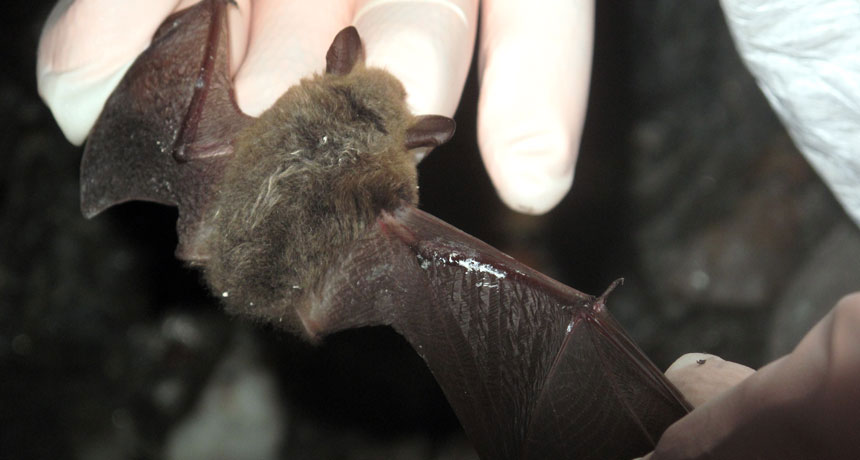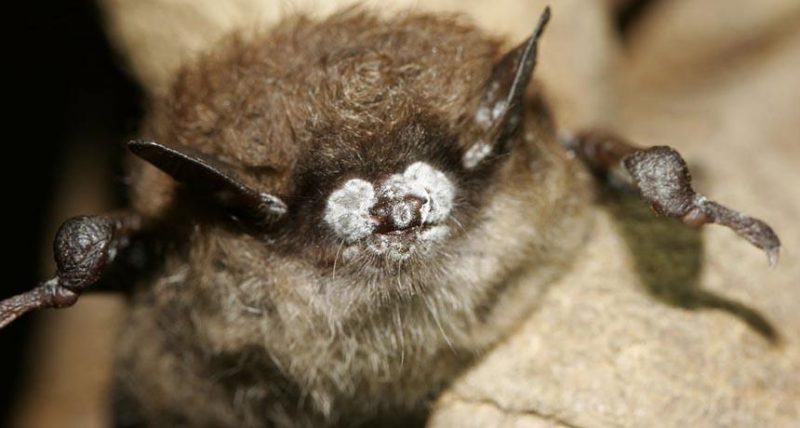New treatment offers hope for bats battling white nose syndrome
Scientists spray bats with bacteria that fight lethal fungi

This bat is being treated with antifungal bacteria. A new study finds the applied germs appear to fight a fungus that’s been killing millions of North American bats.
USFWS/SUE CAMERON/FLICKR (CC BY 2.0)
Since 2006, a fungal disease has wiped out millions of North American bats. It’s called white nose syndrome for the cottony-white fungi that show up on a bat’s face. The infection saps the bats’ energy as they hibernate during winter. But there may be a solution for this epidemic: bacteria.
Not just any bacteria, of course. Joseph Hoyt is an ecologist at Virginia Tech in Blacksburg. He headed a team from across the United States that is working with a bacterium known as Pseudomonas fluorescens (Su-doh-MOH-nus Flor-ESS-enz). Many bats already host these naturally antifungal bacteria. The new treatment merely boosts how many of these helpful germs a bat carries.
Hoyt’s team ran tests on two groups of bats infected with white nose syndrome. One group lived in cages inside an old mine. Another was living in the same place but could fly in and out of the mine. Half of each group was spritzed with the germ spray.
Scientists now report some limited success with squirting a liquid full of the P. fluorescens bacteria onto the bats. Nearly half of the treated animals lived through their winter hibernation. By comparison, just 8 percent of bats in the untreated groups did.
This is not the first time that such biowarfare has been used to tackle white nose syndrome. In 2015, researchers reported successfully treating small numbers of bats with gases spewed by certain bacteria. And earlier this year, scientists reported some success with an oral vaccine against the white-nose fungi.
Hoyt’s group described its promising new findings June 24 in Scientific Reports.
The white nose threat
The cold-loving fungus responsible for white nose syndrome has a very long name: Pseudogymnoascus destructans (SU-doh-jim-noh-AS-kus De-STRUK-tans). It appears to have come from Europe. There, most bats now appear able to fight off the infection. Their North American cousins have not been as successful.
Huge numbers of dying bats first showed up in New York caves. The animals had been hibernating there for the winter. Over the past dozen years, the white-nose epidemic has spread up into Canada, west through the U.S. Midwest to Washington State and then down into Texas. Millions of U.S. and Canadian bats from 12 different bat species have already died. Another 8 U.S. and Mexican species have tested positive for the fungus without yet showing white-nose symptoms.

A 2014 study found that bats can successfully fight off the fungus from about May to mid-October. But their resistance falls to near zero once the bats begin to hibernate.
The infection disrupts that winter rest, when the animals shut down their metabolism to save their energy. Each time they rouse, they start using more energy. If this happens too much, they can use up their fat stores and starve. Some will even leave their winter shelters in search of insects (which aren’t there) and risk dying of exposure in the cold. That’s why many infected bats don’t make it until spring, when bats’ body temps and immune systems ramp up. It’s also when their insect food sources again emerge.
“Bats are really difficult to work with,” says Hoyt. “So being able to pull out some meaningful results from this work was a huge win for us,” he says.
His group learned from previous efforts by scientists to study probiotics. Hoyt pointed to bacterial treatments for amphibians fighting infections of chytrid (KIH-trid) fungus.
Bacteria as medicine
Hoyt set up the outdoor experiment in a Wisconsin mine. There, he and his colleagues treated bats with a strain of Pseudomonas found on bats. In a 2015 study, he and other researchers had identified this strain as being one of the most effective at reducing tissue damage and death by P. destructans fungi.
Before starting the new experiments, the researchers also checked that P. fluorescens or closely related bacteria already had been present on 20 percent of bats in the mine. This helped assure that the research wouldn’t introduce microbes that might harm the animals’ environment.
In November 2015, the researchers caught 30 bats from the mine. They attached an identification tag to a wing of each bat. Then they sprayed the bacterial solution on the wings and tails of 16 of them.
The tags they used were special. They triggered a sensor at the mine’s entry every time one of these bats left or came back. This would let researchers know which bats had roused from their winter rest and attempted to forage (even though there were no insects around for them to eat).
Three treated bats and one untreated bat lost their tags, which removed them from the testing. In early March, the researchers found the remaining tagged bats and swabbed their wings for fungi. A few months later, the scientists collected data from the receiver that had kept tabs on the tagged activity of the supposedly hibernating bats.
The receiver’s data showed that six treated bats survived the winter. Only one of the untreated bats did.
That roughly 50 percent survival rate in the treated bats “is not stellar when you’re thinking of saving a species,” worries Jeremy Coleman. He’s a wildlife biologist who was not involved in the study. He also is the national white-nose-syndrome coordinator for the U.S. Fish and Wildlife Service in Springfield, Mass.
“We’re not likely to find a single treatment that is going to solve this problem,” he admits. The new treatment could likely be tried elsewhere using different antifungal bacteria present at other sites. This should avoid introducing new types of bacteria into an ecosystem.
“Maybe using Pseudomonas with other treatments will get these animals through what we think is a bottleneck event,” says Coleman. By bottleneck, he means some condition that reduces genetic diversity. Given enough time, he and others believe, North American bats probably can evolve natural defenses to the white-nose fungus — as have bats in Europe. They just have to survive long enough for that to happen.







